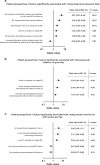Physician and patient perspectives on hypertension management and factors associated with lifestyle modifications in Japan: results from an online survey
- PMID: 31996815
- PMCID: PMC8076050
- DOI: 10.1038/s41440-020-0398-0
Physician and patient perspectives on hypertension management and factors associated with lifestyle modifications in Japan: results from an online survey
Abstract
We conducted a survey to examine the gaps between Japanese physician and patient perspectives on hypertension management and to investigate important factors that may help solve the "hypertension paradox" in Japan. Web-based surveys of patients and physicians were conducted in Japan between October 19 and 31, 2017. The data collected included physician and patient perspectives on hypertension education, adherence to lifestyle modifications and antihypertensive medication, and reasons for treatment adherence/nonadherence. Factors relating to specific patient behaviors (e.g., monitoring their home blood pressure [BP] daily) were analyzed by multivariate logistic regression analysis. Of the 541 physicians and 881 patients included in the analyses, both groups recognized that the extent of lifestyle changes was insufficient. Approximately 80% of physicians reported that they fully or sufficiently provided education to patients about reasons for hypertension treatment and its associated risks, target BP levels, and lifestyle modifications. Only 40-50% of patients considered those topics having been fully or sufficiently discussed. Logistic regression analyses revealed that positive lifestyle modifications (daily home BP monitoring, salt intake <6 g/day, and daily aerobic exercise for ≥30 min) were positively associated with receiving feedback from physicians about specific lifestyle modifications and patient motivation for maintaining their target BP. In conclusion, perception of the amount of education provided by physicians on hypertension management was lower in patients than in physicians. In addition to effective regular follow-up regarding lifestyle modifications, patient motivation by physicians is an important factor for improving lifestyle modifications and achieving effective hypertension management in Japan.
Keywords: Adherence; Education; Hypertension; Hypertension paradox; Lifestyle modification.
Conflict of interest statement
NN, YS, and TY are employees of Takeda Pharmaceutical Co. Ltd, Tokyo, Japan. NH has received honoraria from Takeda Pharmaceutical Industries, Ltd, Japan, Boehringer Ingelheim Co., Ltd, Daiichi Sankyo Co., Ltd, Dainippon Sumitomo Pharmaceutical Co., Ltd, Mochida Pharmaceutical Co., Ltd, and Bristol-Myers Squibb Co., Ltd; scholarships or donations from Astellas Pharma Inc., Otsuka Pharmaceutical Co., Ltd, Daiichi Sankyo Co., Ltd, Takeda Pharmaceutical Industries, Ltd, Teijin Pharma Co., Ltd, Bayer Pharmaceutical Co., Ltd, Dainippon Sumitomo Pharmaceutical Co., Ltd, Medical Corporation Nichiren Kitakyushu Hospital, Nishisei Hospital Enzankai, Genseikai group, Kaiseikai medical group, and Asahikawa Rehabilitation Hospital Shinwakai medical group; and donations for cardiovascular regeneration and advanced medical development course.
Figures




References
-
- GBD 2015 Risk Factors Collaborators. Global, regional, and national comparative risk assessment of 79 behavioural, environmental and occupational, and metabolic risks or clusters of risks, 1990-2015: a systematic analysis for the Global Burden of Disease Study 2015. Lancet. 2016;388:1659–724. doi: 10.1016/S0140-6736(16)31679-8. - DOI - PMC - PubMed
-
- World Health Organization. A global brief on hypertension: silent killer, global public health crisis. 2013. http://www.who.int/iris/handle/10665/79059. Accessed 21 May 2019.
MeSH terms
LinkOut - more resources
Full Text Sources
Medical

